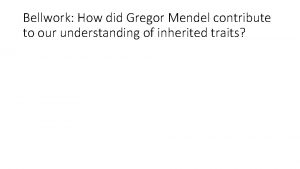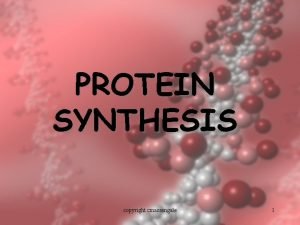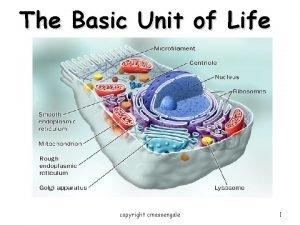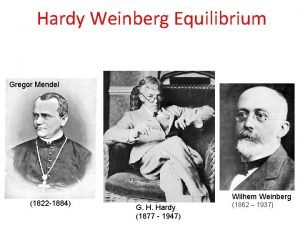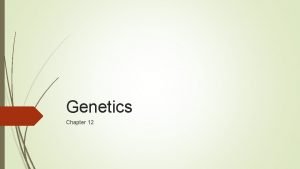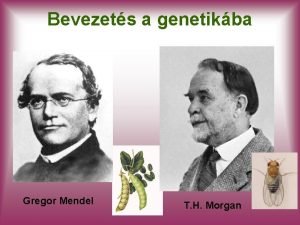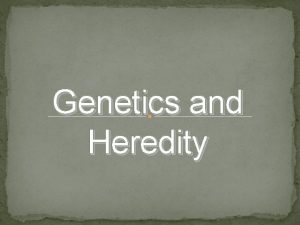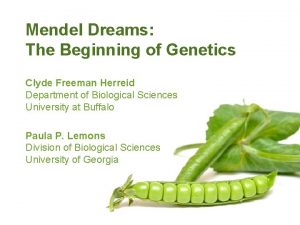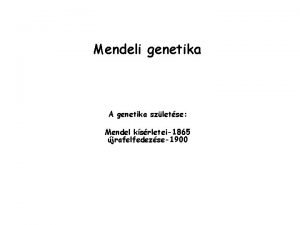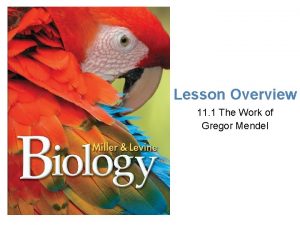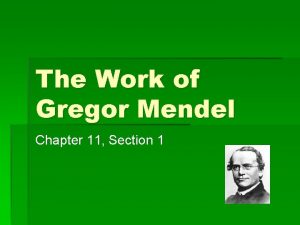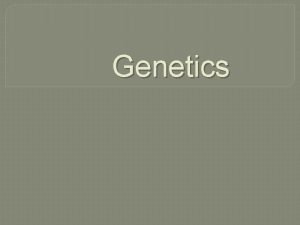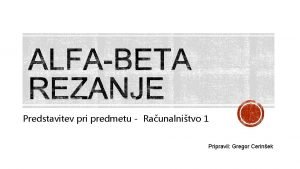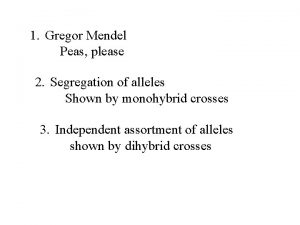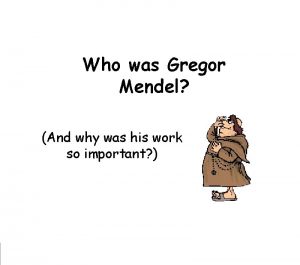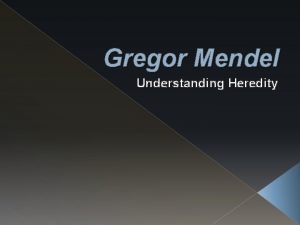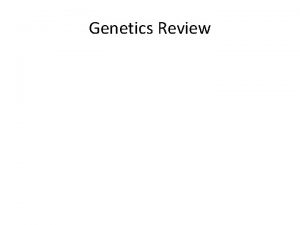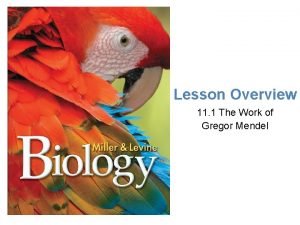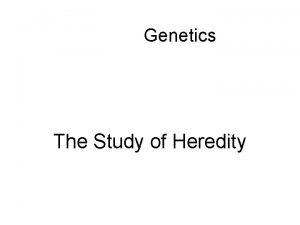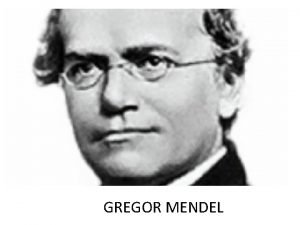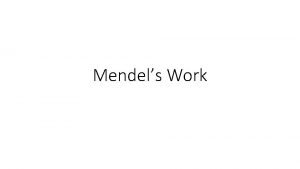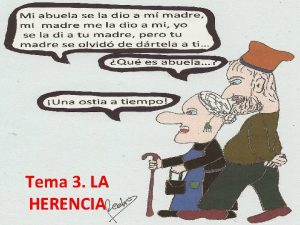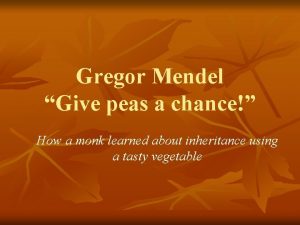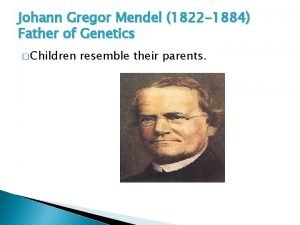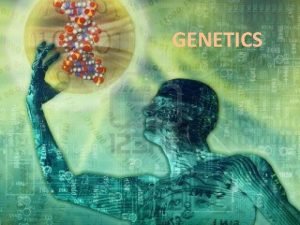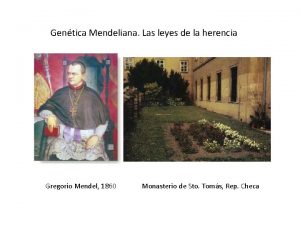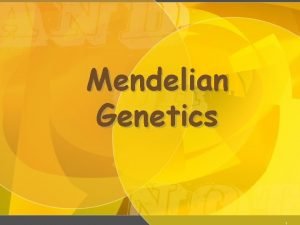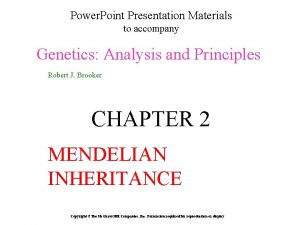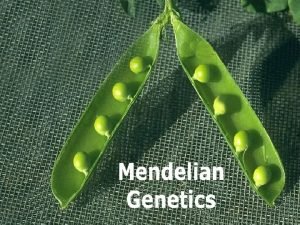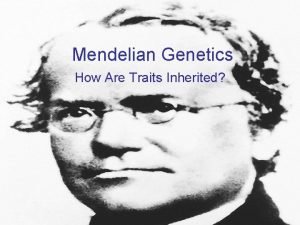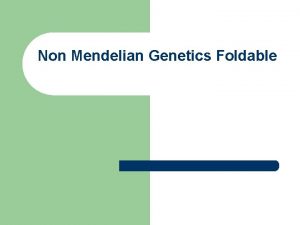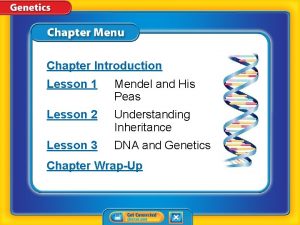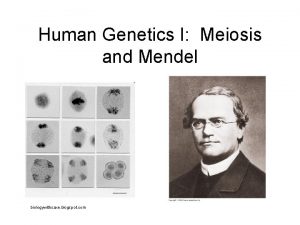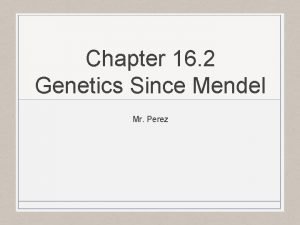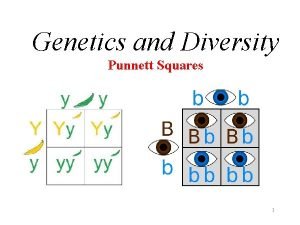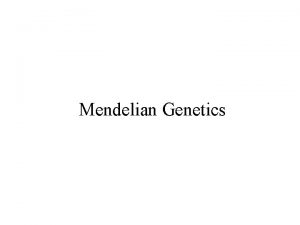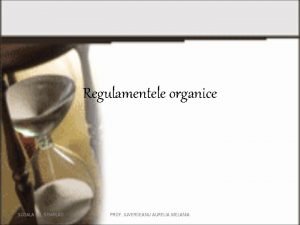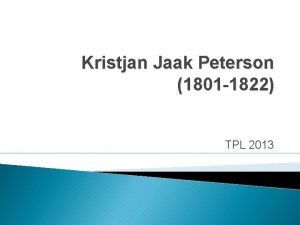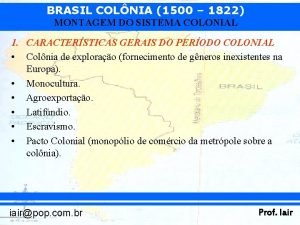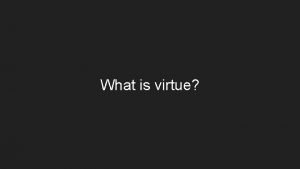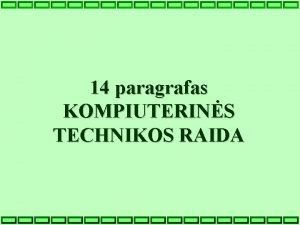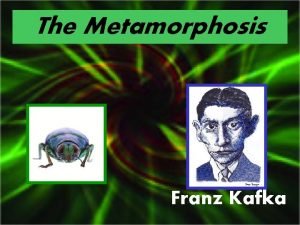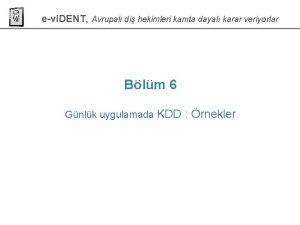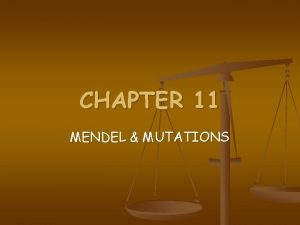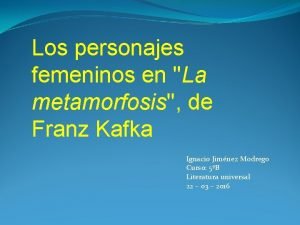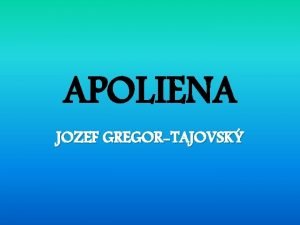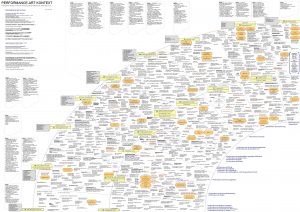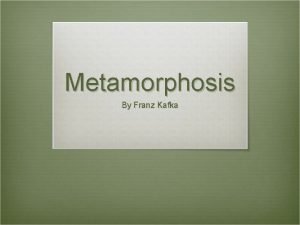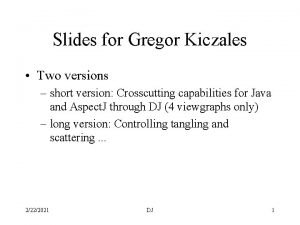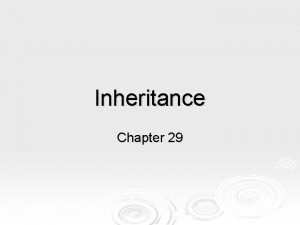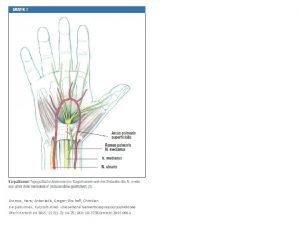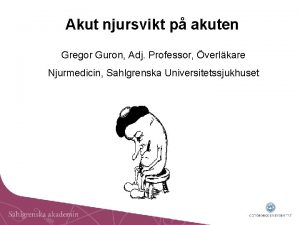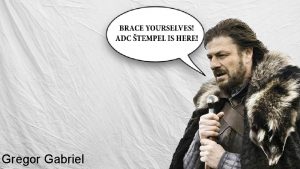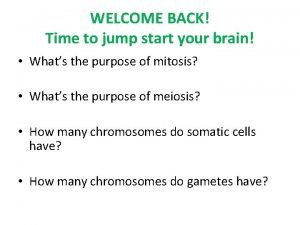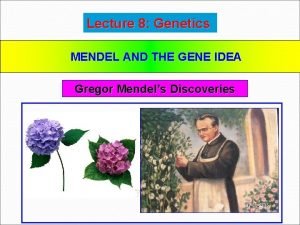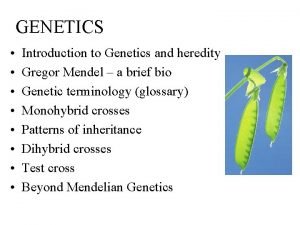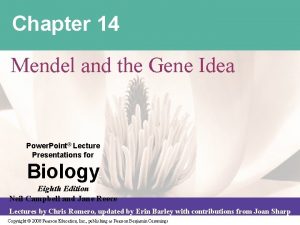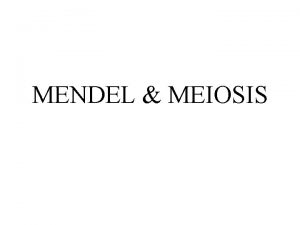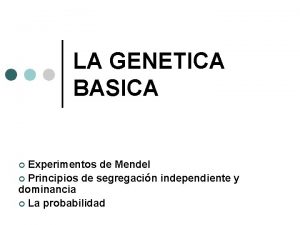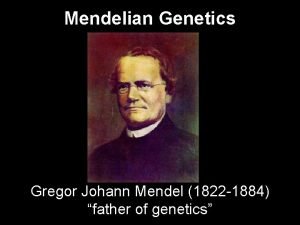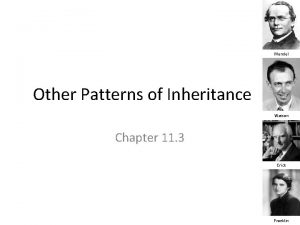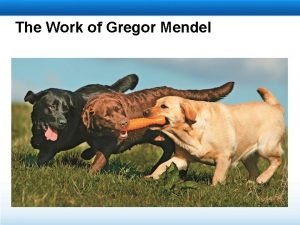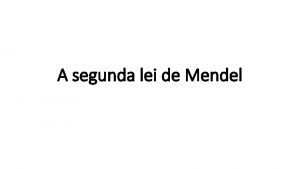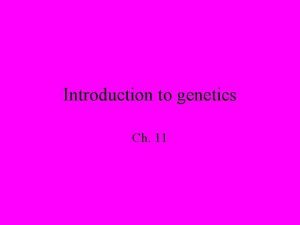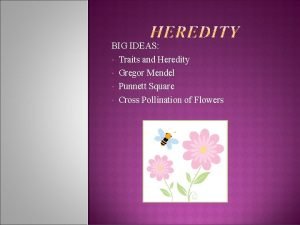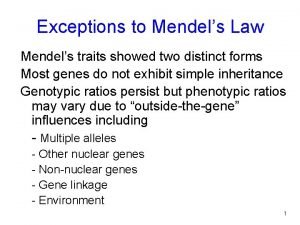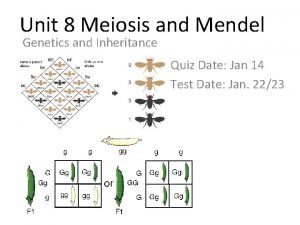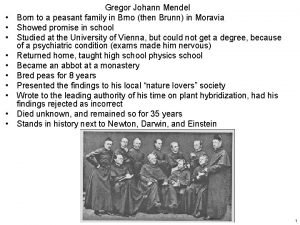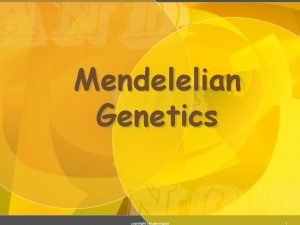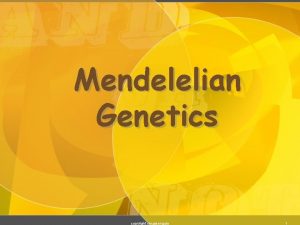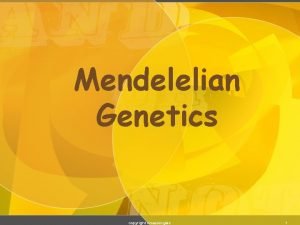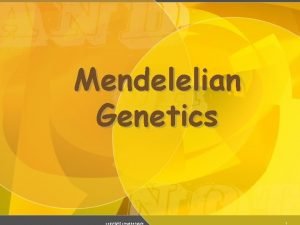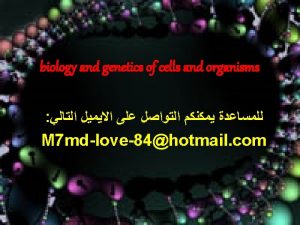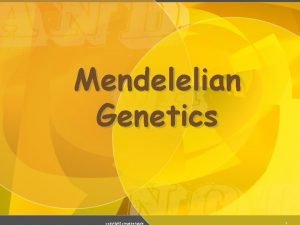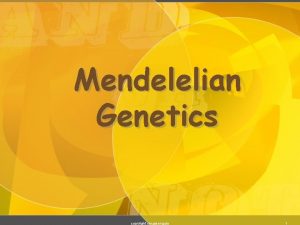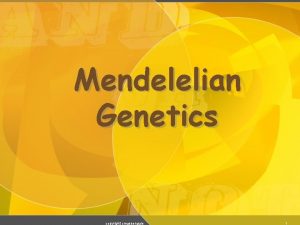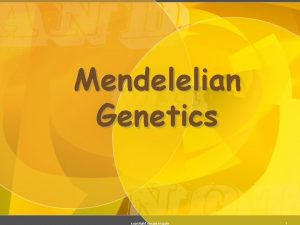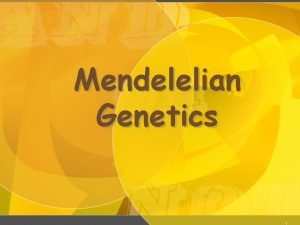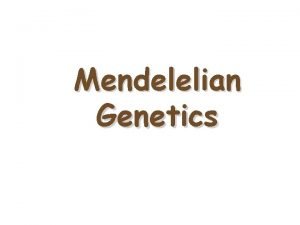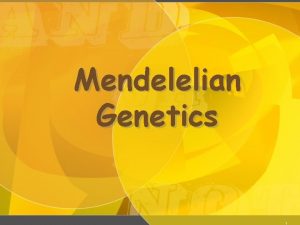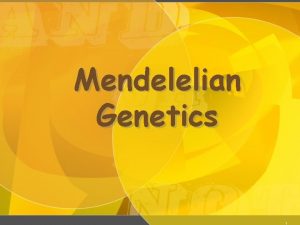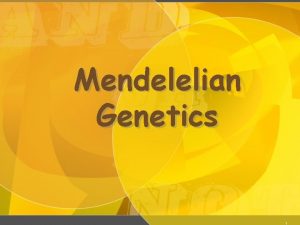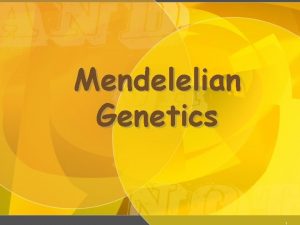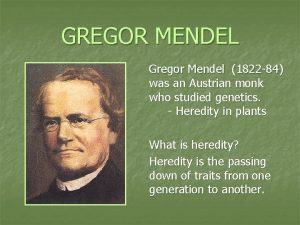Mendelelian Genetics copyright cmassengale 1 Gregor Mendel 1822



















































































































- Slides: 115

Mendelelian Genetics copyright cmassengale 1

Gregor Mendel (1822 -1884) Responsible for the Laws governing Inheritance of Traits copyright cmassengale 2

§§ § § Gregor Johann Mendel Austrian monk Studied the inheritance of traits in pea plants Developed the laws of inheritance Mendel's work was not recognized until the turn of the 20 th century copyright cmassengale 3

§ Gregor Johann Mendel Between 1856 and 1863, Mendel cultivated and tested some 28, 000 pea plants He found that the plants' offspring retained traits of the parents Called the “Father of Genetics" § § copyright cmassengale 4

Site of Gregor Mendel’s experimental garden in the Czech Republic copyright cmassengale 5

Particulate Inheritance § § Mendel stated that physical traits are inherited as “particles” Mendel did not know that the “particles” were actually Chromosomes & DNA copyright cmassengale 6

§ § § Genetic Terminology Trait - any characteristic that can be passed from parent to offspring Heredity - passing of traits from parent to offspring Genetics - study of heredity copyright cmassengale 7

Types of Genetic Crosses § § Monohybrid cross - cross involving a single trait e. g. flower color Dihybrid cross - cross involving two traits e. g. flower color & plant height copyright cmassengale 8

Punnett Square Used to help solve genetics problems copyright cmassengale 9

copyright cmassengale 10

§ § § Designer “Genes” Alleles - two forms of a gene (dominant & recessive) Dominant - stronger of two genes expressed in the hybrid; represented by a capital letter (R) Recessive - gene that shows up less often in a cross; represented by a lowercase letter (r) copyright cmassengale 11

§ § More Terminology Genotype - gene combination for a trait (e. g. RR, Rr, rr) Phenotype - the physical feature resulting from a genotype (e. g. red, white) copyright cmassengale 12

Genotype & Phenotype in Flowers Genotype of alleles: R = red flower r = yellow flower All genes occur in pairs, so 2 alleles affect a characteristic Possible combinations are: Genotypes RR Rr rr Phenotypes RED YELLOW copyright cmassengale 13

§ Genotypes Homozygous genotype - gene combination involving 2 dominant or 2 recessive genes (e. g. RR or rr); also called pure Heterozygous genotype - gene combination of one dominant & one recessive allele (e. g. Rr); also called hybrid § copyright cmassengale 14

Genes and Environment Determine Characteristics copyright cmassengale 15

Mendel’s Pea Plant Experiments copyright cmassengale 16

Why peas, Pisum sativum? § § Can be grown in a small area Produce lots of offspring Produce pure plants when allowed to self -pollinate several generations Can be artificially cross-pollinated copyright cmassengale 17

Reproduction in Flowering Plants Pollen contains sperm Produced by the stamen Ovary contains eggs Found inside the flower Pollen carries sperm to the eggs for fertilization Self-fertilization can occur in the same flower Cross-fertilization can occur between flowers copyright cmassengale 18

Mendel’s Experimental Methods Mendel hand-pollinated flowers using a paintbrush He could snip the stamens to prevent self -pollination Covered each flower with a cloth bag He traced traits through the several generations copyright cmassengale 19

How Mendel Began Mendel produced pure strains by allowing the plants to selfpollinate for several generations copyright cmassengale 20

Eight Pea Plant Traits Seed shape --- Round (R) or Wrinkled (r) Seed Color ---- Yellow (Y) or Green (y) Pod Shape --- Smooth (S) or wrinkled (s) Pod Color --- Green (G) or Yellow (g) Seed Coat Color ---Gray (G) or White (g) Flower position---Axial (A) or Terminal (a) Plant Height --- Tall (T) or Short (t) Flower color --- Purple (P) or white (p) copyright cmassengale 21

copyright cmassengale 22

copyright cmassengale 23

Mendel’s Experimental Results copyright cmassengale 24

Did the observed ratio match theoretical ratio? The theoretical or expected ratio of plants producing round or wrinkled seeds is 3 round : 1 wrinkled Mendel’s observed ratio was 2. 96: 1 The discrepancy is due to statistical error The larger the sample the more nearly the results approximate to theoretical ratio copyright cmassengale 25

Generation “Gap” Parental P 1 Generation = the parental generation in a breeding experiment. F 1 generation = the first-generation offspring in a breeding experiment. (1 st filial generation) From breeding individuals from the P 1 generation F 2 generation = the second-generation offspring in a breeding experiment. (2 nd filial generation) From breeding individuals from the F 1 generation copyright cmassengale 26

Following the Generations Cross 2 Results in Cross 2 Hybrids Pure all get Plants Hybrids 3 Tall & 1 Short TT x tt Tt TT, Tt, tt copyright cmassengale 27

Monohybrid Crosses copyright cmassengale 28

P 1 Monohybrid Cross Trait: Seed Shape Alleles: R – Round r – Wrinkled Cross: Round seeds x Wrinkled seeds RR x rr r r R Rr Rr Genotype: Rr Phenotype: Phenotype Round Genotypic Ratio: All alike Phenotypic Ratio: All alike copyright cmassengale 29

P 1 Monohybrid Cross Review § §§ § Homozygous dominant x Homozygous recessive Offspring all Heterozygous (hybrids) Offspring called F 1 generation Genotypic & Phenotypic ratio is ALL ALIKE copyright cmassengale 30

F 1 Monohybrid Cross Trait: Seed Shape Alleles: R – Round r – Wrinkled Cross: Round seeds x Round seeds Rr x Rr R RR Rr rr Genotype: RR, Rr, rr Phenotype: Phenotype Round & wrinkled G. Ratio: 1: 2: 1 P. Ratio: 3: 1 copyright cmassengale 31

F 1 Monohybrid Cross Review §§ §§ § Heterozygous x heterozygous Offspring: 25% Homozygous dominant RR 50% Heterozygous Rr 25% Homozygous Recessive rr Offspring called F 2 generation Genotypic ratio is 1: 2: 1 Phenotypic Ratio is 3: 1 copyright cmassengale 32

What Do the Peas Look Like? copyright cmassengale 33

…And Now the Test Cross Mendel then crossed a pure & a hybrid from his F 2 generation This is known as an F 2 or test cross There are two possible testcrosses: Homozygous dominant x Hybrid Homozygous recessive x Hybrid copyright cmassengale 34

F 2 Monohybrid Cross st (1 ) Trait: Seed Shape Alleles: R – Round r – Wrinkled Cross: Round seeds x Round seeds RR x Rr R RR Rr Genotype: RR, Rr Phenotype: Phenotype Round Genotypic Ratio: 1: 1 Phenotypic Ratio: All alike copyright cmassengale 35

F 2 Monohybrid Cross (2 nd) Trait: Seed Shape Alleles: R – Round r – Wrinkled Cross: Wrinkled seeds x Round seeds rr x Rr R r r Rr Rr r rr rr Genotype: Rr, rr Phenotype: Phenotype Round & Wrinkled G. Ratio: 1: 1 P. Ratio: 1: 1 copyright cmassengale 36

F 2 Monohybrid Cross Review §§ §§ Homozygous x heterozygous(hybrid) Offspring: 50% Homozygous RR or rr 50% Heterozygous Rr Phenotypic Ratio is 1: 1 Called Test Cross because the offspring have SAME genotype as parents copyright cmassengale 37

Practice Your Crosses Work the P 1, F 1, and both F 2 Crosses for each of the other Seven Pea Plant Traits copyright cmassengale 38

Mendel’s Laws copyright cmassengale 39

Results of Monohybrid Crosses Inheritable factors or genes are responsible for all heritable characteristics Phenotype is based on Genotype Each trait is based on two genes, one from the mother and the other from the father True-breeding individuals are homozygous ( both alleles) are the same copyright cmassengale 40

Law of Dominance In a cross of parents that are pure for contrasting traits, only one form of the trait will appear in the next generation. All the offspring will be heterozygous and express only the dominant trait. RR x rr yields all Rr (round seeds) copyright cmassengale 41

Law of Dominance copyright cmassengale 42

Law of Segregation During the formation of gametes (eggs or sperm), the two alleles responsible for a trait separate from each other. Alleles for a trait are then "recombined" at fertilization, producing the genotype for the traits of the offspring. copyright cmassengale 43

Applying the Law of Segregation copyright cmassengale 44

Law of Independent Assortment Alleles for different traits are distributed to sex cells (& offspring) independently of one another. This law can be illustrated using dihybrid crosses. copyright cmassengale 45

Dihybrid Cross A breeding experiment that tracks the inheritance of two traits. Mendel’s “Law of Independent Assortment” a. Each pair of independently b. Formula: 2 n alleles segregates during gamete formation (n = # of heterozygotes) copyright cmassengale 46

Question: How many gametes will be produced for the following allele arrangements? Remember: 2 n (n = # of heterozygotes) (count the number of traits that have both the dominant and recessive. ) 1. Rr. Yy 2. Aa. Bb. CCDd 3. Mm. Nn. Oo. PPQQRrss. Tt. Qq copyright cmassengale 47

Answer: 1. Rr. Yy: 2 n = 22 = 4 gametes RY Ry r. Y ry 2. Aa. Bb. CCDd: 2 n ABCD ABCd a. BCD a. BCd = 23 = Ab. CD ab. CD 8 gametes Ab. Cd ab. CD 3. Mm. Nn. Oo. PPQQRrss. Tt. Qq: 2 n = 26 = 64 gametes copyright cmassengale 48

Dihybrid Cross Traits: Seed shape & Seed color Alleles: R round r wrinkled Y yellow y green Rr. Yy x Rr. Yy RY Ry r. Y ry All possible gamete combinations copyright cmassengale 49

Dihybrid Cross RY Ry r. Y ry copyright cmassengale 50

Dihybrid Cross RY RY RRYY Ry RRYy r. Y Rr. YY ry Rr. Yy Ry r. Y ry RRYy Rr. YY Rr. Yy RRyy Rr. Yy Rryy Rr. Yy rr. YY rr. Yy Rryy rr. Yy rryy copyright cmassengale Round/Yellow: 9 Round/green: 3 wrinkled/Yellow: 3 wrinkled/green: 1 9: 3: 3: 1 phenotypic ratio 51

Dihybrid Cross Round/Yellow: 9 Round/green: 3 wrinkled/Yellow: 3 wrinkled/green: 1 9: 3: 3: 1 copyright cmassengale 52

Test Cross A mating between an individual of unknown genotype and a homozygous recessive individual. Example: bb. C__ x bbcc BB Bb bb = = = brown eyes blue eyes CC = curly hair Cc = curly hair cc = straight hair b. C b___ bc copyright cmassengale 53

Test Cross Possible results: bc b. C b___ C bb. Cc or copyright cmassengale bc b. C b___ c bb. Cc bbcc 54

Summary of Mendel’s laws LAW DOMINANCE SEGREGATION INDEPENDENT ASSORTMENT PARENT CROSS OFFSPRING TT x tt tall x short 100% Tt tall x x Tt tall Rr. Gg x Rr. Gg round & green x round & green copyright cmassengale 75% tall 25% short 9/16 round seeds & green pods 3/16 round seeds & yellow pods 3/16 wrinkled seeds & green pods 1/16 wrinkled seeds & yellow pods 55

Incomplete Dominance and Codominance copyright cmassengale 56

Incomplete Dominance F 1 hybrids have an appearance somewhat in between the phenotypes of the two parental varieties. Example: snapdragons (flower) red (RR) x white (rr) r r RR = red flower rr = white flower R R copyright cmassengale 57

Incomplete Dominance r r R Rr Rr produces the F 1 generation All Rr = pink (heterozygous pink) copyright cmassengale 58

Incomplete Dominance copyright cmassengale 59

Incomplete dominance in carnations

Codominance Two alleles are expressed (multiple alleles) in heterozygous individuals. Example: blood type 1. 2. 3. 4. type A B AB O = = IAIA or IAi IBIB or IBi I AI B ii copyright cmassengale 61

Codominance Problem Example: homozygous male Type B (IBIB) x heterozygous female Type A (IAi) IA i IB I AI B I Bi copyright cmassengale 1/2 = IAIB 1/2 = IBi 62

Another Codominance Problem • Example: male Type O (ii) x female type AB (IAIB) IA IB i I Ai I Bi copyright cmassengale 1/2 = IAi 1/2 = IBi 63

ABO blood types

Multiple alleles for the ABO blood groups

Codominance Question: If a boy has a blood type O and his sister has blood type AB, what are the genotypes and phenotypes of their parents? boy - type O (ii) AB (IAIB) X copyright cmassengale girl - type 66

Codominance Answer: IA IB i i I AI B ii Parents: genotypes = IAi and IBi phenotypes = A and B copyright cmassengale 67

More exceptions to the dominant/recessive rule Pleiotropy: One genes having many effects. Only one gene affects an organism in many ways. Ex: sickle cell anemia and cystic fibrosis

Pleiotropy Alleles at a single locus may have effects on two or more traits Classic example is the effects of the mutant allele at the beta-globin locus that gives rise to sicklecell anemia

A single gene may affect many phenotypic characteristics In pleiotropy A single gene may affect phenotype in many ways Individual homozygous for sickle-cell allele Sickle-cell (abnormal) hemoglobin Abnormal hemoglobin crystallizes, causing red blood cells to become sickle-shaped Clumping of cells and clogging of small blood vessels Breakdown of red blood cells Physical weakness Anemia Impaired mental function Figure 9. 14 5, 555 Sickle cells Heart failure Paralysis Pain and fever Pneumonia and other infections Accumulation of sickled cells in spleen Brain damage Damage to other organs Rheumatism Spleen damage Kidney failure

Genetics of Sickle-Cell Anemia Two alleles 1) Hb. A Encodes normal beta hemoglobin chain 2) Hb. S Mutant allele encodes defective chain Hb. S homozygotes produce only the defective hemoglobin; suffer from sickle-cell anemia

Epistasis: Interaction between the products of gene pairs Interaction between two genes in which one of the genes modifies the expression of the other. Ex: fur /hair color in mammals and albinism

Albinism Phenotype results when pathway for melanin production is completely blocked Genotype - Homozygous recessive at the gene locus that codes for tyrosinase, an enzyme in the melanin-synthesizing pathway

Genetics of Coat Color in Labrador Retrievers Two genes involved - One gene influences melanin production Two alleles - B (black) is dominant over b (brown) - Other gene influences melanin deposition Two alleles - E promotes pigment deposition and is dominant over e

Allele Combinations and Coat Color Black coat - Must have at least one dominant allele at both loci BBEE, Bb. Ee, BBEe, or Bb. EE Brown coat - bb. EE, bb. Ee Yellow coat - Bbee, Bb. EE, BBee, bbee

An example of epistasis

More modifications to Mendel’s rule Polygenic Inheritance: In this case many genes have an additive effect. The characteristic or trait is the result of the combined effect of several genes. Ex: human skin color, height. Controlled by more than one pair of genes

Continuous Variation Polygenic inheritance results in a continuous range of small differences in a given trait among individuals The greater the number of genes that affect a trait, the more continuous the variation in versions of that trait

A simplified model for polygenic inheritance of skin color

Environmental effects: The degree to which an allele is expressed depends on the environment Ex: Siamese cat fur color ( enzyme for melanin production inhibited by heat), hydrangea flowers ( depends on acidity of soil), height (nutrition)

Temperature Effects on Phenotype Himalayan rabbits are Homozygous for an allele that specifies a heat-sensitive version of an enzyme in melanin-producing pathway Melanin is produced in cooler areas of body

Environmental Effects on Plant Phenotype Hydrangea macrophylla Action of gene responsible for floral color is influenced by soil acidity Flower color ranges from pink to blue

The effect of environment of phenotype

Web sites to check http: //gslc. genetics. utah. edu/units/basics/tour/inhe ritance. swf http: //science. nhmccd. edu/biol/genetics. html http: //library. thinkquest. org/20465/games. html

Thomas Hunt Morgan (1910) and Sex Linked Inheritance Morgan’s Experimental Evidence: Scientific Inquiry The first solid evidence associating a specific gene with a a specific chromosome came from Thomas Hunt Morgan’s experiments with fruit flies (Columbia University, 1910) provided convincing evidence that chromosomes are the location of Mendel’s heritable factors. He provided confirmation of the correctness of the chromosomal theory of inheritance.

Morgan’s experiments Demonstrated the role of crossing over in inheritance Experiment Black body, vestigial wings Gray body, long wings (wild type) Gg. LI ggll Male Female Offspring Gray long Black vestigial Gray vestigial Black long 965 944 206 185 Parental phenotypes Recombinant phenotypes 391 recombinants Recombination frequency = Explanation Gg. LI (female) G L 2, 300 total offspring G L g l g l Gl g. L Eggs G L g l ggll (male) g l Sperm g l Offspring Figure 9. 20 C = 0. 17 or 17% G l g L g l

Thomas Hunt Morgan Performed some of the early studies of crossing over using the fruit fly Drosophila melanogaster Figure 9. 20 B

Sex-linked Traits (genes) located on the sex chromosomes Sex chromosomes are X and Y XX genotype for females XY genotype for males Many sex-linked traits carried on X chromosome copyright cmassengale 88


Sex-linked Traits Example: Eye color in fruit flies Sex Chromosomes fruit fly eye color XX chromosome - female Xy chromosome - male copyright cmassengale 90

In Drosophila White eye color is a sex-linked trait Figure 9. 23 A

Sex-linked Trait Problem Example: Eye color in fruit flies (red-eyed male) x (white-eyed female) X RY x X r Remember: the Y chromosome in males does not carry traits. Xr Xr RR = red eyed Rr = red eyed R X rr = white eyed XY = male Y XX = female copyright cmassengale 92

Sex-linked Trait Solution: Xr XR XR Xr Y Xr XR Xr Xr Y 50% red eyed female 50% white eyed male copyright cmassengale 93

SEX LINKED TRAITS ARE THOSE CARRIED BY THE X CHROMOSOME Red-Green color blindness Inability to see those colors. Red and green look all the same , like gray Hemophilia Blood clotting disorder. The clotting factor VIII is not made, individual can bleed to death. Muscular dystrophy X linked recessive, gradual and progressive destruction of skeletal muscles. Faulty teeth enamel Extremely rare, X linked Dominant

Female Carriers copyright cmassengale 95

• Types of genetic screening • Test for carriers (parents) • Newborn Screening – Some genetic disorders can be detected at birth • By simple tests that are now routinely performed in most hospitals in the United States • Antenatal options: fetal blood cell test from maternal blood • Chorionic Villus Sampling (CVS) • Amniocentesis

• Fetal Testing – Amniocentesis and chorionic villus sampling (CVS) • Allow doctors to remove fetal cells that can be tested for genetic abnormalities Chorionic villus sampling (CVS) Amniocentesis Needle inserted through abdomen to extract amniotic fluid Ultrasound monitor Fetus Suction tube inserted through cervix to extract tissue from chorionic villi Fetus Placenta Uterus Chorionic villi Cervix Uterus Amniotic fluid Centrifugation Fetal cells Several weeks Figure 9. 10 A Table 9. 9 Biochemical tests Karyotyping Several hours

DISORDERS RESULTING FROM AUTOSOMAL RECESSIVE INHERITANCE These are conditions in which the gene that is defective is recessive. It is only expressed when the child receives both recessive genes for the disorder (one from each parent) If a person is heterozygous he/she will be a CARRIER but not have the disorder. The dominant allele will mask the expression of the abnormal condition. EXAMPLES: ALBINISM: SICKLE CELL ANEMIA: CYSTIC FIBROSIS: TAY- SACHS DISEASE; PHENYLKETONURIA; GALACTOSEMIA:

DISORDERS RESULTING FROM RECESSIVE INHERITANCE ALBINISM: No pigmentation in skin This is also an example of “EPISTASIS”(one pair of genes modifies the expression of another) SICKLE CELL ANEMIA: This is also an example of “PLEIOTROPY” Red blood cells curved shape. Decreased oxygen to brain and muscles (offers resistance to Malaria)

DISORDERS RESULTING FROM RECESSIVE INHERITANCE CYSTIC FIBROSIS: Excessive mucus secretions. Impaired lung function, lung infections. Protein channel that transport chloride across cell membrane does not function. Protects against cholera. This is also an example of “PLEIOTROPY” TAY –SACHS DISEASE: Nervous system degeneration in infants. Enzyme fails to breakdown lipids which accumulate in nerve cells and kills the cells. Progressive degeneration starting with the brain cells.

DISORDERS RESULTING FROM RECESSIVE INHERITANCE GALACTOSEMIA: Produces brain, liver, eye damage. Enzyme that breaks down lactose is lacking. It accumulates to toxic levels. Death in infancy PHENYLKETONURIA: Results in mental retardation

Disorders resulting from Autosomal Dominant Inheritance Dominant traits appear in each generation since the allele shows in the heterozygous individual.

Dominant Disorders Some human genetic disorders are dominant Figure 9. 9 B

Disorders resulting from Dominant Inheritance Acondroplasia or dwarfism: A condition where the bone does not grow properly and can’t make proper cartilage. Person is less than 4 feet with short arms and legs but a regular size trunk. Cholesterolemia: High cholesterol levels in the blood causing arteries to clog and high incidence of early heart attacks. Marfan Syndrome: Abnormal connective tissue

Disorders resulting from Autosomal Dominant Inheritance Huntington’s Disorder: Progressive degeneration of nervous system and muscle control. Affects motor and mental abilities and it is irreversible. Late onset, usually late 30’s. Usually the person already had children. Progeria: Premature accelerated aging. Usually dead by 18. Genes that bring about growth and development are abnormal. Polydactily: Extra toes and fingers

Karyotype A karyotype is a visual display of an individual’s chromosomes. A man made picture of a person’s 23 pairs of chromosomes. ( the photo is taken during metaphase when the sister chromatids are lined up together) It is useful in sex determination and diagnosis of certain conditions.

CHROMOSOMES CHANGES Chromosome changes can cause a lot of genetic disorders as well as a lot of variety WHEN AND HOW CAN A CHROMOSOME CHANGE? Mistakes in replication. During the S phase of the cell cycle segments of a chromosome could be deleted, duplicated, inverted or moved to a new location. Also during Metaphase I (meiosis) there can be improper separation after duplication. This can change the total number of chromosomes in each gamete of the new individual.

If during meiosis the paired chromatids fail to separate correctly this is called NONDISJUNCTION ANEUPLOIDY means an abnormal number of chromosomes. When an individual ends up with the wrong number of chromosomes most of the time it is miscarried ( spontaneous abortion). The wrong number of somatic chromosomes are almost always lethal. Ex: trisomy 21(three chrom. 21): Down Syndrome You can live with the wrong number of sex pair chromosomes.

CHROMOSOMES X Turner syndrome One X instead of a pair. This happens because of non disjuction of sperm. Most are aborted spontaneously. If they live, she is very short, infertily and with reduced sex characteristics. XXY Klinefelter syndrome One in 500 live male births. Taller than average, infertile, some low intelligence, some normal. Testosterone injections help. XYY “super male” about 1 in 1000. taller, mildly retarded but normal phenotype.

Genetic Practice Problems copyright cmassengale 110

Breed the P 1 generation tall (TT) x dwarf (tt) pea plants t t T T copyright cmassengale 111

Solution: tall (TT) vs. dwarf (tt) pea plants t t T Tt Tt produces the F 1 generation T Tt Tt All Tt = tall (heterozygous tall) copyright cmassengale 112

Breed the F 1 generation tall (Tt) vs. tall (Tt) pea plants T t copyright cmassengale 113

Solution: tall (Tt) x tall (Tt) pea plants T t T TT Tt tt produces the F 2 generation 1/4 (25%) = TT 1/2 (50%) = Tt 1/4 (25%) = tt 1: 2: 1 genotype 3: 1 phenotype copyright cmassengale 114

copyright cmassengale 115
 How did gregor mendel contribute to genetics
How did gregor mendel contribute to genetics Gregor mendel a monk
Gregor mendel a monk Chapter 11 biology test
Chapter 11 biology test Taxons
Taxons Cmassengale
Cmassengale Cmassengale
Cmassengale Gregor mendel
Gregor mendel Suit separate
Suit separate 35 +0 2+1per10
35 +0 2+1per10 Who is gregor mendel and what did he do?
Who is gregor mendel and what did he do? The work of gregor mendel lesson 1 chapter 12
The work of gregor mendel lesson 1 chapter 12 Fr gregor mendel
Fr gregor mendel Mendel traits
Mendel traits Rryy x rryy punnett square
Rryy x rryy punnett square Tesztelő keresztezés
Tesztelő keresztezés Gregor mendel summary
Gregor mendel summary Gregor johann mendel
Gregor johann mendel Chapter 11 the work of gregor mendel
Chapter 11 the work of gregor mendel Gregor mendel austrian monk
Gregor mendel austrian monk What did gregor mendel research
What did gregor mendel research Gregor mendel referat
Gregor mendel referat Who is gregor mendel and what is he famous for
Who is gregor mendel and what is he famous for Gregor mendel punnett square
Gregor mendel punnett square Blood types
Blood types Gregor mendel laws
Gregor mendel laws Gregor mendel chart
Gregor mendel chart Gregor mendel 1865
Gregor mendel 1865 Johann gregor mendel steckbrief
Johann gregor mendel steckbrief How many pairs of chromosomes do humans have? *
How many pairs of chromosomes do humans have? * Gregor mendel
Gregor mendel Gregor mendel mbti
Gregor mendel mbti Who is gregor mendel
Who is gregor mendel Gregor mendel
Gregor mendel Why did mendel prevent his plants from self-pollinating?
Why did mendel prevent his plants from self-pollinating? Gregor mendel
Gregor mendel Gregor mendel plant
Gregor mendel plant Formulacion de la teoria cromosomica de la herencia
Formulacion de la teoria cromosomica de la herencia Chapter 12 lesson 1 the work of gregor mendel
Chapter 12 lesson 1 the work of gregor mendel Gregor mendel
Gregor mendel Law of segregation vs law of independent assortment
Law of segregation vs law of independent assortment Gregor mendel conclusions
Gregor mendel conclusions Cruza dihibrida
Cruza dihibrida Austrian monk
Austrian monk Mendel genetics
Mendel genetics Who was gregor mendel
Who was gregor mendel Gregor mendel laws
Gregor mendel laws ____________is the austrian monk who experimented with
____________is the austrian monk who experimented with Gregor mendel
Gregor mendel Gregor mendels principles of genetics apply to
Gregor mendels principles of genetics apply to Mendel's genetics foldable
Mendel's genetics foldable Solid
Solid Do sister chromatids separate in meiosis
Do sister chromatids separate in meiosis Genetics since mendel
Genetics since mendel Phenotype blue eyes
Phenotype blue eyes 1822
1822 Constitutia carvunarilor 1822
Constitutia carvunarilor 1822 1822
1822 1822
1822 Kristjan jaak peterson luule
Kristjan jaak peterson luule 1822 charvolant
1822 charvolant 1822
1822 Brasil colônia (1500 a 1822 slide)
Brasil colônia (1500 a 1822 slide) Ccc 1814
Ccc 1814 Leibnico mašina
Leibnico mašina La campaña definitiva 1820 a 1822
La campaña definitiva 1820 a 1822 Kjpd zürich neumünsterallee 3
Kjpd zürich neumünsterallee 3 Metamorphosis tim roth
Metamorphosis tim roth 1915 book gregor
1915 book gregor Gregor kiczales
Gregor kiczales Gregor mohorcic
Gregor mohorcic Gregor slavicek
Gregor slavicek Biografia de gregor kiczales
Biografia de gregor kiczales Gregor kiczales
Gregor kiczales Gregor papa
Gregor papa Jozef gregor tajovsky najznamejsie diela
Jozef gregor tajovsky najznamejsie diela Gregor mendol
Gregor mendol Hermana de gregorio samsa
Hermana de gregorio samsa What is this process called
What is this process called Aleks jakulin
Aleks jakulin Gregor hackman
Gregor hackman Nespoľahlivý rozprávač
Nespoľahlivý rozprávač Gregor leschig
Gregor leschig The metamorphosis activities
The metamorphosis activities Gregor kiczales
Gregor kiczales Gregor mendal
Gregor mendal Brochures mc gregor
Brochures mc gregor Gregor benčina
Gregor benčina Kubitaltunnel
Kubitaltunnel Gregor guron
Gregor guron Shrin david porno
Shrin david porno Gregor andrade
Gregor andrade Gabriel gregor
Gabriel gregor Mendel's second law of independent assortment
Mendel's second law of independent assortment 11.2 applying mendel's principles
11.2 applying mendel's principles Mendel
Mendel Inheritance vs heredity
Inheritance vs heredity To infinity and beyond in latin
To infinity and beyond in latin Grzegorz mendel
Grzegorz mendel Chapter 14 mendel and the gene idea
Chapter 14 mendel and the gene idea Mendel meiosis
Mendel meiosis Que muestra
Que muestra Father johann
Father johann Mendel
Mendel Mendel
Mendel Mendel
Mendel Legge di mendel
Legge di mendel 2a lei de mendel
2a lei de mendel Mendel's monohybrid cross
Mendel's monohybrid cross Mendel
Mendel Mendel's first and second law of inheritance
Mendel's first and second law of inheritance Mendel
Mendel What causes stomach ulcers
What causes stomach ulcers Exception to mendel's laws
Exception to mendel's laws Genotype vs phenotype ratio
Genotype vs phenotype ratio Heterozgot
Heterozgot Mendel was born in
Mendel was born in
